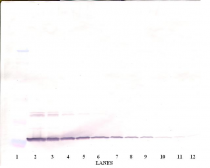ARG66111
anti-Artemin antibody (Biotin)
anti-Artemin antibody (Biotin) for ELISA,Western blot and Human
Overview
| Product Description | Biotin-conjugated Rabbit Polyclonal antibody recognizes Artemin |
|---|---|
| Tested Reactivity | Hu |
| Tested Application | ELISA, WB |
| Host | Rabbit |
| Clonality | Polyclonal |
| Isotype | IgG |
| Target Name | Artemin |
| Antigen Species | Human |
| Immunogen | E. coli derived recombinant Human Artemin. (AGGPGSRARA AGARGCRLRS QLVPVRALGL GHRSDELVRF RFCSGSCRRA RSPHDLSLAS LLGAGALRPP PGSRPVSQPC CRPTRYEAVS FMDVNSTWRT VDRLSATACG CLG) |
| Conjugation | Biotin |
| Alternate Names | ENOVIN; Neublastin; EVN; Artemin; Enovin; NBN |
Application Instructions
| Application Suggestion |
|
||||||
|---|---|---|---|---|---|---|---|
| Application Note | * The dilutions indicate recommended starting dilutions and the optimal dilutions or concentrations should be determined by the scientist. |
Properties
| Form | Liquid |
|---|---|
| Purification | Purified by affinity chromatography. |
| Buffer | PBS (pH 7.2) |
| Concentration | 1 mg/ml |
| Storage Instruction | Aliquot and store in the dark at 2-8°C. Keep protected from prolonged exposure to light. Avoid repeated freeze/thaw cycles. Suggest spin the vial prior to opening. The antibody solution should be gently mixed before use. |
| Note | For laboratory research only, not for drug, diagnostic or other use. |
Bioinformation
| Database Links | |
|---|---|
| Gene Symbol | ARTN |
| Gene Full Name | artemin |
| Background | The protein encoded by this gene is a member of the glial cell line-derived neurotophic factor (GDNF) family of ligands which are a group of ligands within the TGF-beta superfamily of signaling molecules. GDNFs are unique in having neurotrophic properties and have potential use for gene therapy in neurodegenerative disease. Artemin has been shown in culture to support the survival of a number of peripheral neuron populations and at least one population of dopaminergic CNS neurons. Its role in the PNS and CNS is further substantiated by its expression pattern in the proximity of these neurons. This protein is a ligand for the RET receptor and uses GFR-alpha 3 as a coreceptor. Multiple transcript variants encoding different isoforms have been found for this gene. [provided by RefSeq, Oct 2008] |
| Function | Ligand for the GFR-alpha-3-RET receptor complex but can also activate the GFR-alpha-1-RET receptor complex. Supports the survival of sensory and sympathetic peripheral neurons in culture and also supports the survival of dopaminergic neurons of the ventral mid-brain. Strong attractant of gut hematopoietic cells thus promoting the formation Peyer's patch-like structures, a major component of the gut-associated lymphoid tissue. [UniProt] |
| Calculated MW | 23 kDa |
Images (4) Click the Picture to Zoom In
-
ARG66111 anti-Artemin antibody (Biotin) WB image
Western blot: 250 - 0.24 ng of Human Artemin stained with ARG66111 anti-Artemin antibody (Biotin), under non-reducing conditions.
-
ARG66111 anti-Artemin antibody (Biotin) standard curve image
Direct ELISA: ARG66111 anti-Artemin antibody (Biotin) at 0.25 - 1.0 µg/ml results of a typical standard run with optical density reading at 405 - 650 nm.
-
ARG66111 anti-Artemin antibody (Biotin) WB image
Western blot: 250 - 0.24 ng of Human Artemin stained with ARG66111 anti-Artemin antibody (Biotin), under reducing conditions.
-
ARG66111 anti-Artemin antibody (Biotin) standard curve image
Sandwich ELISA: ARG66111 anti-Artemin antibody (Biotin) as a detection antibody at 0.25 - 1.0 µg/ml combined with ARG66110 anti-Artemin antibody as a capture antibody. Results of a typical standard run with optical density reading at 405 - 650 nm.









